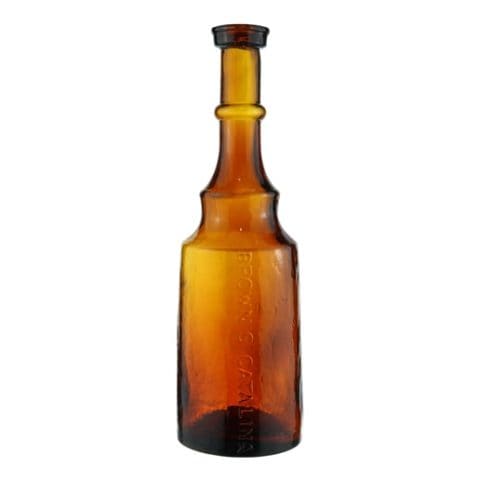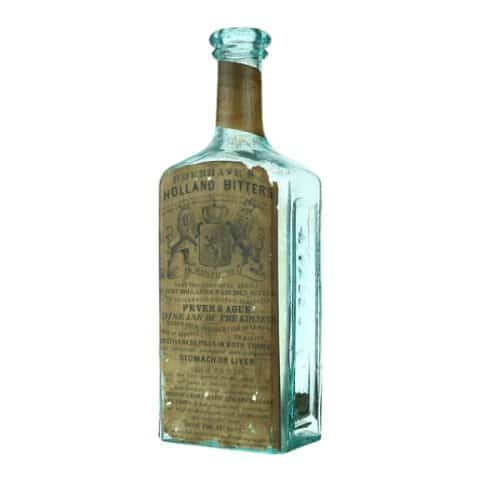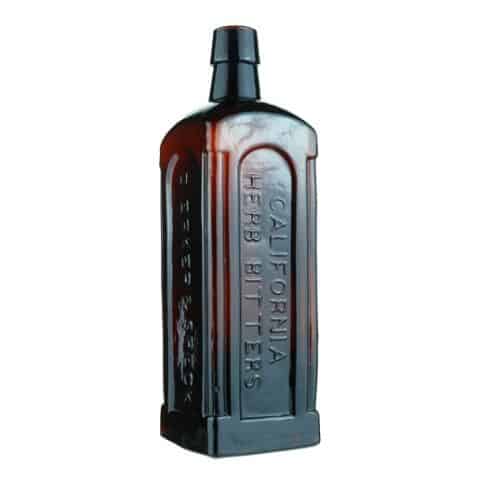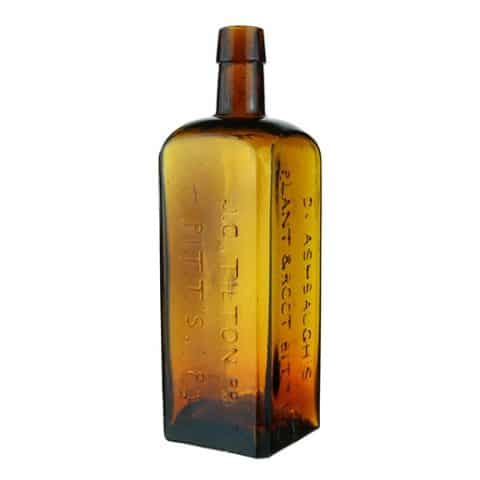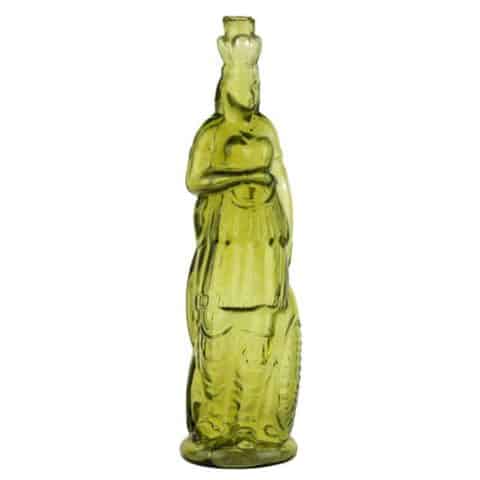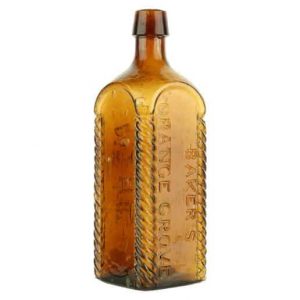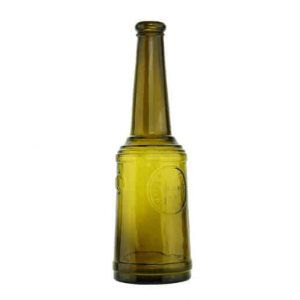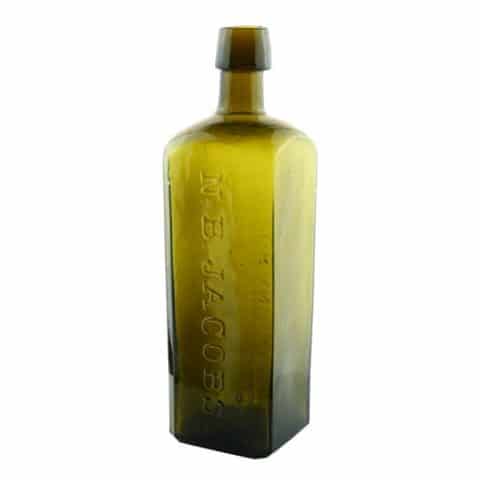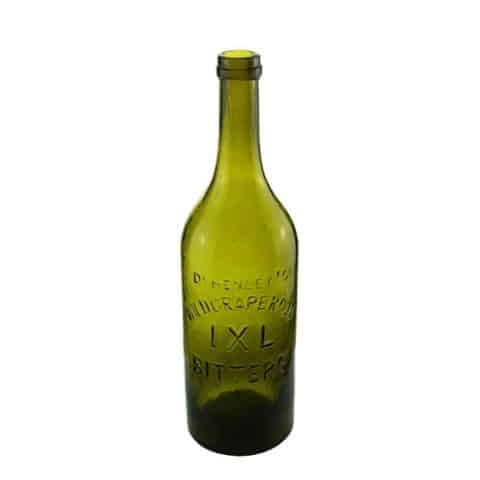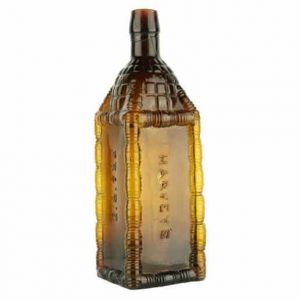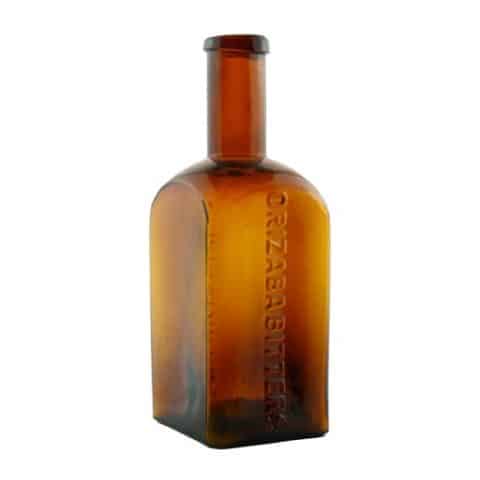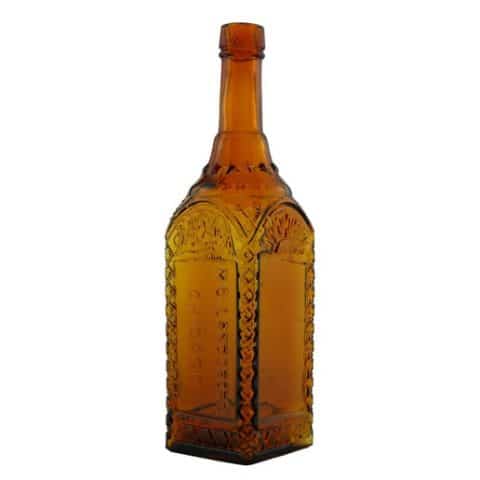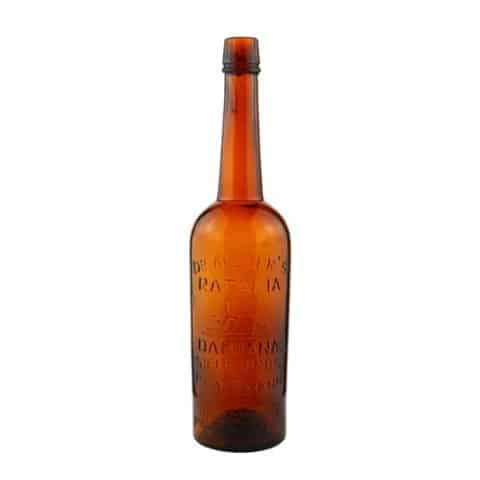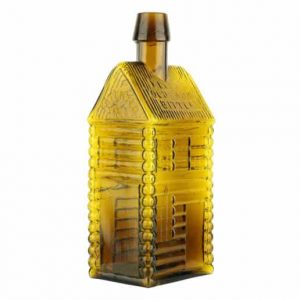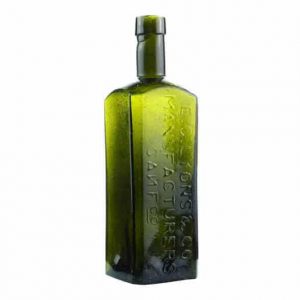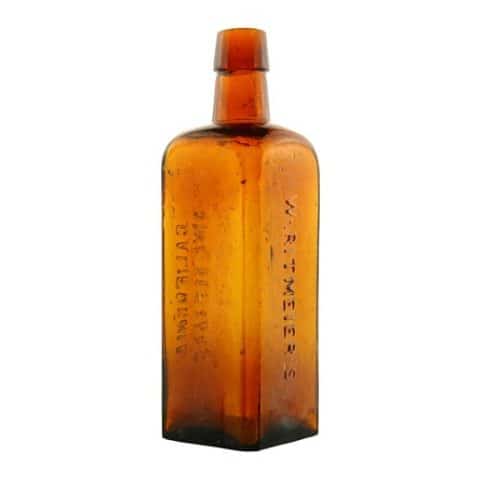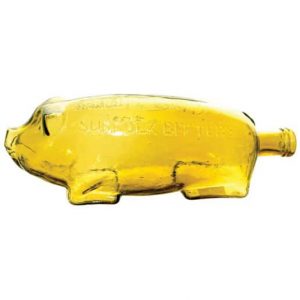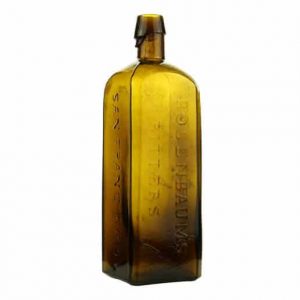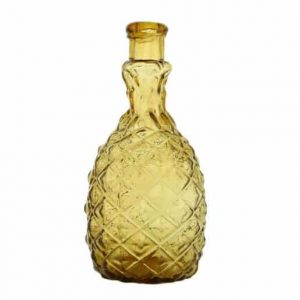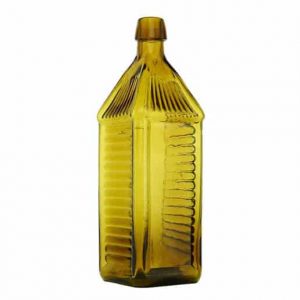Chalmer’s Catawba Wine Bitters
Chalmer’s
Catawba Wine Bitters
Trade Mark
Sutter’s Old Mill
Spruance Stanley & Co.
Proprietors
C 119
Robert Chalmers, Coloma, California
Sprance, Stanley & Co., San Francisco, California
Aquamarine Cylinder
Provenance: Richard T. Siri Collection

In our community of antique bottle collecting, most western bottle collectors would include Chalmer’s Catawba Wine Bitters with the best of the west. For those fortunate enough to possess one, they are well-versed with the incredible bottle displayed on their shelf or within a cabinet. An amazing addition to any collection east or west, these highly embossed western bitters bring both an aesthetic brilliance as well as a historically significant American story to any collection.
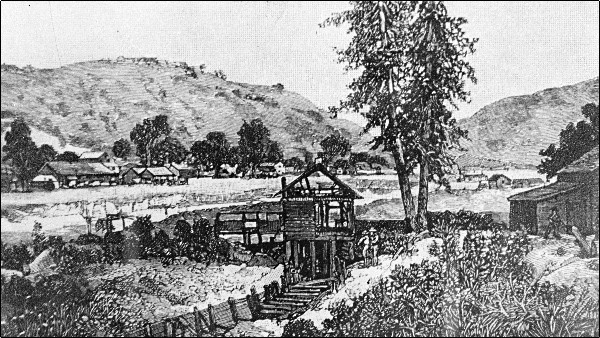
A prominently embossed motif of a cabin in the woods on the bottle face represents Sutter’s Mill. James Marshall’s discovery of gold in the South Fork of the American River at Sutter’s mill on January 24, 1848, started the great rush of Argonauts to California. Marshall and Captain John Sutter tried their best to keep the discovery of gold quiet until the construction of Sutter’s mill was completed, well knowing that the workmen would desert their jobs and turn to dig gold. The news leaked out, and the stampede began.

Robert Chalmers was the eldest of fourteen children born to William and Elizabeth (nee Templeton) Chalmers who were natives of Scotland and married in Kilmarnock.
Robert was born May 24, 1820, and moved with his parents to Haldimand County, Canada, in 1834. His boyhood days were spent on his father’s farm where he built a strong work ethic and developed an understanding of the land. When he was 19 years old he married Katie Ferrier, also a native of Scotland. For a short time, he engaged himself at rope making, and as a fireman on a steamer on Lake Erie, after which he purchased a farm in the forests of Haldimand County.
When the news of the discovery of gold in California reached Canada, Chalmers was one of the first locals to catch the inspiration. He disposed of his farm and settled his family near the old home, and in April 1850, started for California. The steamer on which he took passage up the Missouri River was burned and he, with others of his party, lost all their effects except what was on their backs. Chalmers was not deterred and continued across the plains and arrived at Coloma, California in the autumn of the same year.
For a while, Chalmers mined in various claims about Coloma and eventually started working for a man named Homes in his bakery business. While in this position he saved about $2,500, and in January 1852 returned to the east; but after a short time, he longed for the climate and activity of California life and again crossed the plains with his family, arriving at Coloma in September 1852.
It was during this time that Robert Chalmers turned to grape growing. In the late 1850s, Martin Allhoff planted 20 acres or so of Catawba grapes near Coloma. These grapes were the result of crossbreeding and cultivation of wild American grapes beginning in the 1700s in the eastern states.
See and read about our museum example of a Catawba Wine Bitters by Longworth & Zimmermann in Ohio.
In 1861, encouraged by early experiments in growing these new grapes, the California governor sent an expatriated Hungarian viticulturist named Agoston Haraszthy abroad to obtain the widest possible variety of grapevine cuttings for experimentation. He returned with 100,000 cuttings representing about 300 varieties. The wine industry that developed has often been referred to as California’s “real gold rush.”

Now an established vintner operating from Coloma, California, Robert Chalmers had over 100,000 bearing vines by 1870. To get to this point he had purchased the Coloma Vineyard from Martin Allhoff.
Chalmers filed the above Trade Mark 0236, Registered December 6, 1873, for wines, cordials, and brandies. He was actually selling his Chalmer’s Catawba Wine Bitters at least a year prior to registering his trade mark, which was also used for a number of his other wines, cordials, brandy, etc. It was only natural for him to put out a bitters product with his wine as a base. It is interesting to note has close the trade mark illustration is to the finished embossing on the bottle.
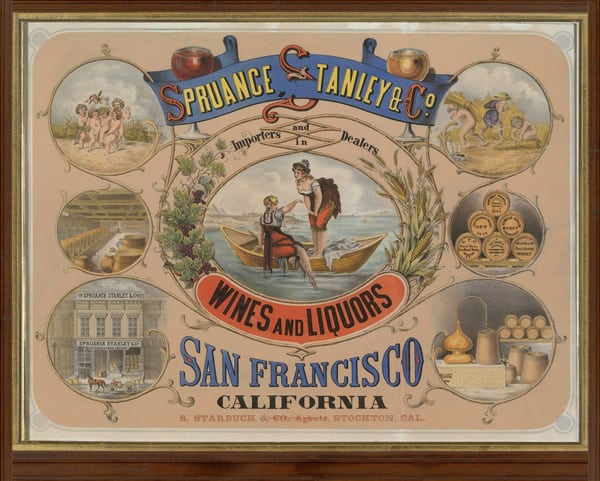
The proprietors of the Chalmers Catawba Wine Bitters brand were Spruance Stanley & Co. out of San Francisco. Their claim to fame was African Stomach Bitters which was extremely popular and profitable. J & J Spruance was the initial name of the company established in 1868 that survived until 1872. John Spruance then partnered with Samuel L. Stanley to create Spruance, Stanley & Co. About this time, they developed a business relationship with Robert Chalmers and took over the Chalmers Catawba Wine Bitters. Their ‘Spruance & Stanley & Co.’ name and the word ‘Proprietors’ is embossed on the bottle.
The round Chalmer’s Catawba Wine Bitters bottle has the appearance of a whiskey bottle and can be found in green and blue shades of aqua. They are embossed top to bottom and have no fewer than nine curved “R’s” which is the typographic signature of a product from San Francisco Glass Works on King Street near 4th in San Francisco. It is reported that the majority of the bottles were shipped to Nevada and Utah as this is where the bottles have been advertised and found. There are approximately 12-15 examples of the Chalmer’s Catawba Wine Bitters bottle known in any condition in collections.
The Carlyn Ring and W.C. Ham listing in Bitters Bottles is as follows:

C 119 CHALMER’S / CATAWBA WINE BITTERS ( au ) / TRADE ( cu ) MARK ( cd ) / motif oval with cabin in woods / SUTTERS ( cd ) OLD MILL ( cu ) SPRUANCE STANLEY & CO ( ad ) / PROPRIETORS // c //
11 ¾ x 3 ¼ (6)
Round, Aqua, LTCR, Applied mouth, Very rare
San Francisco, California
Chalmers bought the Alhoff Vineyard. Spruance & Stanley were the proprietors of the bitters in 1872-73 when the vineyard discontinued growing Catawba grapes.
Also manufacturers of African Stomach Bitters.
There is an even rarer Chalmer’s Catawba Wine Bitters bottle without the “Sutters Old Mill” embossed copy. Only one intact example is known. The bottle is cataloged as C 119.5.

C 119.5 CHALMER’S / CATAWBA WINE BITTERS ( au ) / TRADE ( cu ) MARK ( cd ) / motif – oval with cabin in woods / SPRUANCE STANLEY & CO ( ad ) / PROPRIETORS // c //
Round, Aqua, LTCR, Applied mouth, Extremely rare
The difference between this bottle and bottle C 119 is that the embossing “Sutters Old Mill” is not present.
One known example was found in Montana. The fragments of an embossed faceplate were dug in Nevada. The Chalmer’s Bitters is one of the most historic Western bottles and one of the top Western bitters.
Primary Image: Chalmer’s Catawba Wine Bitters bottle imaged by the FOHBC Virtual Museum midwest studio by Alan DeMaison.
Support Image: Blue aqua Chalmer’s Catawba Wine Bitters and detail shot – Bruce Silva, Western Whiskey Gazette
Support Image: Chalmer’s Catawba Wine Bitters sits proudly on a home work desk. – Jerry Forbes collection
Support Image: Green aqua Chalmer’s Catawba Wine Bitters and detail shot – Jeff Wichmann, American Bottle Auctions
Support Image: Auction Lot 36: “CHALMER’S / CATAWBA WINE BITTERS / TRADE MARK / (motif of a cabin in the woods) / SUTTER’S OLD MILL / SPRUANCE STANLEY & CO / PROPRIETORS”, (C-119), California, ca. 1872 – 1875, light apple green with subtle deeper color striations in the shoulder and neck. 12”h, smooth base, applied mouth. Some very slight interior haze exists that we mention only for accuracy, otherwise in perfect condition. Curt Paget Collection. You are bidding on what is believed to be one of the finest known examples of this very historic bitters bottle. An exceptionally bold impression, some glass whittle, and in a slightly different color! – Jim Hagenbuch, Glass Works Auctions
Support: Reference to The Journal of Robert Chalmers, April 17 – September 1, 1850. – Utah Historical Quarterly, edited by Charles Kelly
Support: Reference to Bitters Bottles by Carlyn Ring and W. C. Ham. Use of Chalmer’s Catawba Wine Bitters illustration courtesy Bill Ham.
Support: Reference to Chalmer’s Catawba Wine Bitters – The West’s First and Only Commemorative Bitters – Jeff Wichmann, American Bottle Auctions.
Support: Eric McGuire and Ferdinand Meyer V research. Peachridge Glass image archives.
Join the FOHBC: The Virtual Museum is a project of the Federation of Historical Bottle Collectors (FOHBC). To become a member.





